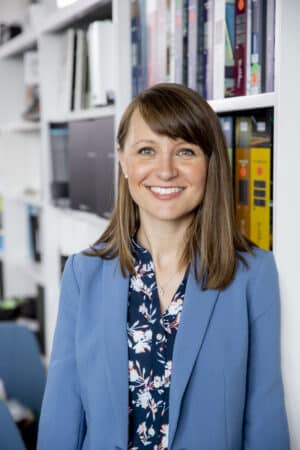Natasha Pirman
Lab programmer and planner, TRIA Architects
Age: 36
Industry experience: 14 years
After Natasha Pirman’s employer moved to a new campus in 2017, she began thinking about a career change. As the biochemistry Ph.D. and her MilliporeSigma colleagues settled into their new Burlington labs, she realized she had a knack for organizing their new workspaces. Those skills translated well into the world of architecture, where local firms are looking for new hires with life science backgrounds as they pursue work designing office and labs to satisfy the industry’s relentless expansion. Pirman joined Boston-based TRIA Architects in May as a lab programmer and planner, where she’s worked on projects including ElevateBio’s new lab and manufacturing facility under construction in Waltham.
Q: How did you hear about the opportunity at TRIA and why did it make sense to change fields?
A: A huge portion of that was MilliporeSigma’s move to Burlington. When we did that, our lab space consolidated quite a bit. There were a lot of decisions that needed to be made: how do we best utilize the new space? How do we make it work now that we have less space? I volunteered to lay out the instruments in the lab and who worked where. It was probably one of the favorite things that I did at Millipore, and I recognized that that was not at all what my job as an application scientist was. I figured out you can actually have a career doing that, as a lab planner. Serendipitously, TRIA was looking to increase their lab planners capacity. That’s why it was a great fit for me to move here, because they specialize in life science and tech space.
Q: What’s the structure of your team at TRIA and how does your role fit in?
A: We have the lab planners group, including four lab planners and support people. Everyone else has an architecture background, so I am the newest scientist on the team. So far, a big focus is I’m trying to learn how to be a lab planner, but I bring a different perspective to the table. I consider it like the voice of a client. I represent the end users a little bit more.
Q: What new wrinkles have you brought to TRIA’s work through your outsider’s perspective?
A: We interview the end users and analyze the workflows and what they’re doing in the lab, how they’re utilizing the space, in the hopes of trying to see a more efficient space in the future. I’ve been able to grasp how they work and why a piece of equipment or room might need to have that closer adjacency: just not having to run between multiple buildings and lab space to do that. With some of the clients, they do care about what other groups they’re located next to, the people they collaborate with.
Q: How does data collection and analysis play into your role?
A: That’s a huge part of what I do. In being a lab planner, we do a lot of collecting data from clients. Some of that is looking at their current layout and square-footage, and if they’re growing, how much space do they need to increase by?
Q: What projects are you currently working on?
A: I’ve been focused on two main [confidential] projects. They’re widely different. One is a smaller company that recently went public, and they have the ability to expand and grow significantly. It’s understanding what research they do and their growth needs, and how to fit them into a space. The other one is a much larger pharmaceutical company that is really trying to understand all of the different functions within that company and how they work together and how much space they need.
Q: How do you compare the workplace cultures in life science and architecture?
A: Architecture seems to be very fast-paced, and we’re working for clients who need to grow and move quickly. Whereas in life science, you’re still trying to develop a product. You were making something for someone, but not for one specific person. That changes the timeline and scope of what we do: getting a product to market.
Q: In what areas of architecture are you looking to grow your skills?
A: With the company I’m with now and the fact that we specialize in science and technology, I enjoy bringing that to the table. But I feel a newfound passion for design and understanding what goes into the space and why. I’ve been really trying to take that all in. In science, you take that for granted. I’m really trying to understand more of the details of why science spaces are designed the way they are, and also learning some of the software that architects use here in making the drawings, wrapping my head around this as a whole and continuing to grow a little bit every day.
Five Favorite Restaurants Around Boston:
- Blossom Bar in Brookline
- CafeSushi in Cambridge
- SRV in South End
- Brewer’s Fork in Charlestown
- The Bangkok in Melrose




 |
| 
